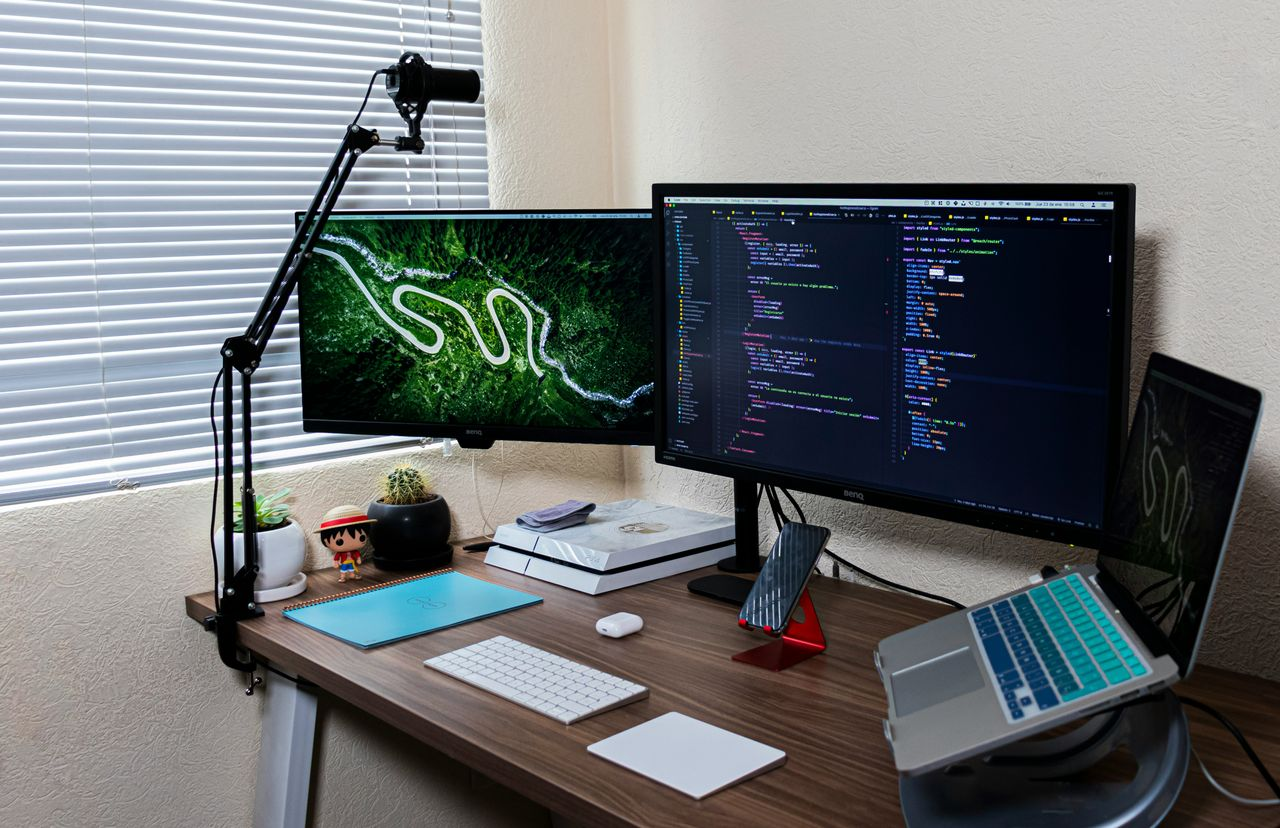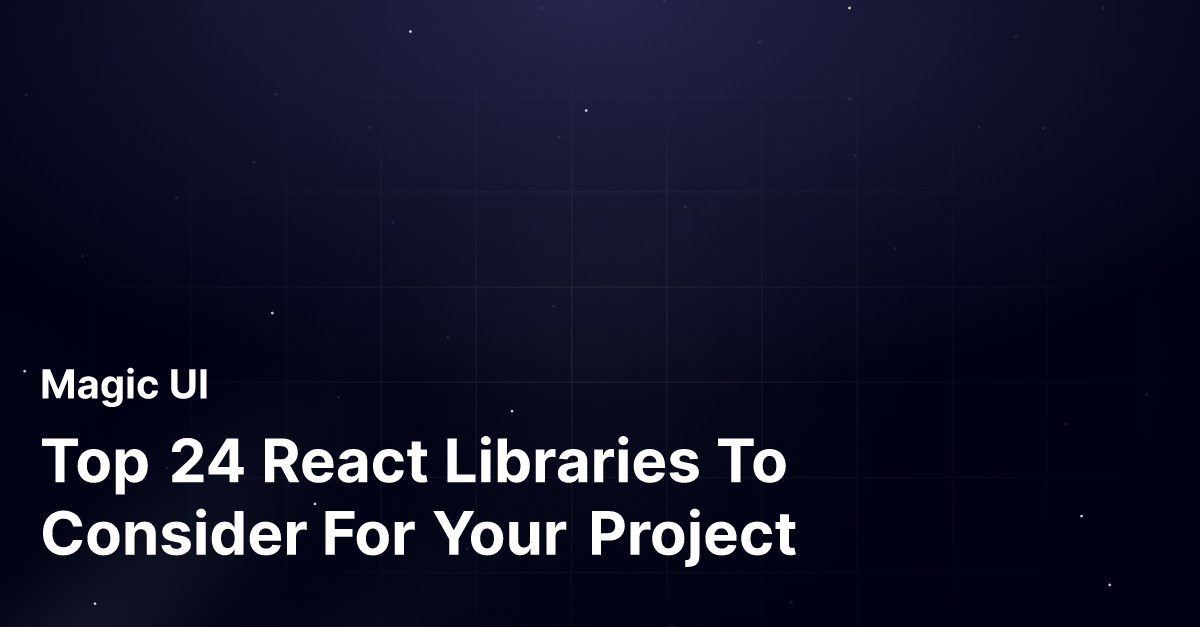Are you getting into React Libraries to expand your UI Frameworks knowledge? Imagine facing numerous React libraries, each offering unique features and benefits. Navigating this landscape can be overwhelming. This blog will help you understand the different React libraries available, compare their features, and choose the ideal one for your project.
Introducing Magic UI's React component library, a valuable asset that will assist you in learning about various React libraries, comparing their features, and determining which library best suits your project needs.
What Are React UI Component Libraries?

React UI component libraries are collections of ready-to-use or pre-coded user interface elements that help accelerate software development. These pre-designed elements range from buttons, modals, and cards to complex components like data tables and charts. React UI component libraries are created to simplify the creation of user interfaces by providing developers with building blocks and elements that follow best practices in design and accessibility.
Consistency and Efficiency in Design and Development
These component libraries are particularly useful in collaborative design and development environments, as they help ensure that all team members are using the same source of truth and that the end product maintains a professional and polished appearance. Component library can reduce the risk of any product variation, or ending up with different components in different places. They handle the source code for UI elements and usually leverage CSS and JavaScript.
Component libraries mitigate the need to re-create these elements from scratch for each new project, making the development process faster and more efficient.
If you are interested in learning more about React libraries, visit here.
Related Reading
- React Frameworks
- What Are UI Components
- What Is A Component Library
- React CSS Framework
- React Design Patterns
- Component Libraries
- React Best Practices
Why Use React Component Libraries?

React UI libraries and component collections offer numerous advantages, making them a compelling choice for developers.
Some of the key use cases for React component libraries include:
1. Implementing common UI patterns
Component libraries provide a wide range of pre-built UI components that can be used to implement common UI patterns. This can save developers significant time and effort, as they do not have to design and develop these components from scratch.
2. Ensuring consistency
React UI component libraries help ensure consistency across projects, benefiting large teams working on multiple projects.
3. Enhancing quality
Top React component libraries are often well-tested and maintained, ensuring high quality.
4. Reducing development costs
Developers can reduce overall development costs by using the best component libraries for React.
5. Increased productivity
By using pre-built components, developers can save a significant amount of time and effort. This allows them to focus on the more complex aspects of their applications.
6. Reduced risk
Well-tested and maintained libraries help to reduce the risk of introducing bugs into applications.
7. Access to expertise
Component libraries are often developed by teams of experienced developers. This means that developers can benefit from the expertise of these developers when using their libraries.
8. Community support
Many component libraries have active communities of users. This means that developers can get help and support from other users if they encounter problems.
Bridging the Gap Between Design and Development
MagicUI is a free and open-source UI library that we designed specifically for design engineers. It offers a collection of over 20 animated components built with React, TypeScript, Tailwind CSS, and Framer Motion. We provide a range of visually appealing and interactive elements that can be easily integrated into web applications, allowing us to create stunning user interfaces with minimal effort. MagicUI components are highly customizable, enabling seamless adaptation to match our desired branding and design requirements.
With a focus on animation and a design-centric approach, MagicUI aims to bridge the gap between design and development, empowering us to craft captivating digital experiences. Along with our free component library, with MagicUI Pro, you can save thousands of hours and create a beautiful landing page, and convert your visitors into customers with our website templates.
Use our React component library for free today at https://magicui.design/docs.
Factors To Consider When Choosing React Libraries

1. Project Needs
React libraries should offer the components and features that your project requires. Consider the scale and type of your project and any specific needs you might have. For instance, if you are working on a large enterprise application, you need a library that can handle a high level of complexity.
2. Longevity
You want to choose a React library that is updated regularly and likely to be supported in the future. Active maintenance ensures you won't have to migrate to a new library soon.
3. Learning Curve
The library you choose should be easy for you or a new developer to pick up. If you're working in a team, choosing a library that's easy for new developers to learn is important.
4. Customizability
Some libraries are more customizable than others. If you have specific design requirements, you should choose a library that can be tailored to meet your needs
5. Community
A large and active community can support and help you solve any problems you encounter while using the library.
6. Documentation
Good documentation can simplify learning how to use the library and help you find solutions to any problems that might arise.
7. Performance
When choosing a React component library, it's essential to consider how it performs. Some libraries are more performant than others. If a highly performant library is important to you, choose one known for its speed and responsiveness.
Related Reading
- Best React Native UI Library
- React Component Best Practices
- Tailwind Vs Bootstrap
- Material UI Alternatives
- Best React Component Library
- React Tips
- Create React Component Library
- Cool React Components
- Component Library Examples
- Bootstrap Vs React
- React Native Libraries
- Best React UI Framework
- NextJS
- Next.JS
- Next JS
- React Bootstrap
- MUI Table
- MUI Card
- MUI Box
- What Is NextJS
Top 24 React Libraries To Consider For Your Project

1. Magic UI
MagicUI is a free and open-source UI library that we designed specifically for design engineers. It offers a collection of over 20 animated components built with React, TypeScript, Tailwind CSS, and Framer Motion. We provide a range of visually appealing and interactive elements that can be easily integrated into web applications, allowing us to create stunning user interfaces with minimal effort. MagicUI components are highly customizable, enabling seamless adaptation to match our desired branding and design requirements.
With a focus on animation and a design-centric approach, MagicUI aims to bridge the gap between design and development, empowering us to craft captivating digital experiences. Along with our free component library, with MagicUI Pro, you can save thousands of hours and create a beautiful landing page, and convert your visitors into customers with our website templates.
Use our React component library for free today at https://magicui.design/docs.
Features of Magic UI
Magic UI is a free and open-source UI library that offers over 20 animated components built with React, TypeScript, Tailwind CSS, and Framer Motion. The library provides visually appealing and interactive elements for easy integration into web applications, helping create stunning user interfaces with minimal effort.
Magic UI components are highly customizable, allowing seamless adaptation to match desired branding and design requirements. The focus on animation and a design-centric approach aims to bridge the gap between design and development, enabling the creation of captivating digital experiences. Magic UI Pro offers website templates to save time and create beautiful landing pages for better conversion rates.
2. Material UI
Material UI is a React component library that implements Google's Material Design. It provides a comprehensive collection of pre-built components ready for use in production right out of the box.
Features
Pre-built components
A comprehensive collection of pre-built components, including buttons, forms, tables, charts, and more.
Accessibility
A focus on accessibility, ensuring that all components meet the highest standards for usability.
Customizability
A suite of customization options that make it easy to implement your own custom design system.
Theme support
Support for theming, allowing you to change the look and feel of your entire application easily.
Strong community
A large and active community of users and contributors.
3. Next.js
Next.js is a React.js framework developed by Vercel. It has unique features as compared to other frameworks like server-side rendering and enhanced search engine optimization. It provides a built-in routing feature giving it an edge over React. Prior knowledge of HTML, CS, JS and React is required before learning Next.js.
Features
Hot Code Reloading
As soon as any changes are saved in your code, they will automatically reflect in your user interface.
Server Rendering
The next.js rendering feature enables you to render react components to the server side first before sending it to the HTML client which helps enhance SEO.
Automatic Routing
For any project the files in the page directory are automatically mapped and do not require additional coding for routing.
Prefetching
The link component that links various pages together supports prefetching of the resources in the background.
4. Ant Design
Ant Design is a React component library that implements Ant UMD, a design system for enterprise applications. It provides a comprehensive collection of pre-built components that are ready for use in production right out of the box.
Features
Enterprise-level components
Ant Design provides various enterprise-level components, such as data tables, form layouts, and organization charts.
Professional look
Ant Design's design system is more heavily influenced by Chinese design principles, resulting in a more elegant and professional look and feel
Out-of-the-box features
Ant Design offers several out-of-the-box features that are not available in Material UI, such as internationalization support and type safety
Customizability
Customizable options that simplify the implementation of your custom design system.
5. Semantic UI React
Semantic UI React is a React component library that implements the Semantic UI CSS framework. It provides a comprehensive collection of pre-built components that are ready for use in production right out of the box.
Features
- Semantic UI React is built around the concept of semantic HTML
- Semantic UI React is committed to accessibility, and all of its components are designed to meet the Web Content Accessibility Guidelines (WCAG) standards
- Theming
- Semantic UI React is extensible
6. MobX
MobX is a simple and scalable state management library for React applications. It provides a straightforward way to manage the application state, making it easier to keep data in sync with the UI and ensuring smooth reactivity.
MobX is a versatile choice for developers who want to manage the state of their React applications efficiently, especially for projects with complex data flows and interactions.
Features
- Observable state
- Derived values
- Reactions
- Easy debugging
- Middleware support
7. Rebass
Rebass is a React component library that simplifies building responsive and consistent user interfaces. With a focus on design procedure principles and minimalism, Rebass provides a set of UI components that are highly customizable and themeable. It's an excellent choice for creating aesthetically pleasing and user-friendly React applications with ease.
Features
- Functional React UI components
- Theming support
- Minimalistic
- Extendable
- Highly composable
8. React Admin
React Admin is a framework developed for building admin interfaces and dashboards. It helps streamline the overall procedure of developing data-heavy applications, offering features like CRUD operations, and data handling.
React Admin is an invaluable tool for developers working on applications that require robust data management and user management functionalities.
Features
- Easy CRUD operations
- Pluggable architecture
- Data validation
- Internationalization
- Customizable UI
9. Material Tailwind - React
Material Tailwind is a popular design system and component library. When combined with React, using this library becomes a powerful tool for creating stunning and responsive web applications.
This library seamlessly merges the Material Design aesthetic with the utility-first approach of Tailwind CSS. It provides a wide array of pre-designed components, UI elements, and styles, that helps developers to build modern and visually appealing interfaces with ease. Material Tailwind for React is a practical addition to the toolkit of developers who aim to deliver user-friendly and aesthetically pleasing web applications while leveraging the efficiency of the Tailwind CSS utility classes.
Features
- Tailwind CSS with Material Design
- Prebuilt components
- Easy customization
- Responsiveness built-in
- Dark mode support
10. Grommet
Grommet is another React UI component library known for its accessibility and simplicity. It provides a set of ready-to-use components designed to focus on responsiveness and accessibility. This Grommet library has signified itself for Javascript developers who prioritize creating web applications that are user-friendly and adhere to accessibility standards.
Features
- Accessibility-first components
- Themable
- Responsive design
- Dark mode
- Server-side rendering
11. Material Kit React
When talking about the best UI framework for React, one cannot overlook Material Kit. Inspired by Google’s Material Design, Material Kit builds a group of elements that give consistency as the primary feature. This feature enables you to maintain a similarity of appearance and functions in your project throughout. The layout is like that of multiple sheets of paper, giving it depth and order.
Features
- Grants access to the theme values from the component props
- Open source, extremely fast, and high-quality
- Less than KB gzipped
- Developer-first product with a solid community
- Supports several variables
- Good UI consistency with an effortless and responsive layout
- Follows code standards
- MIT license
12. Storybook
Another special mention on our React JS framework list is Storybook. Storybook has been popular among developers for a long time now. This is not a component library itself. It is more like an open-source tool that is used for building UI components in isolation for React and several other platforms and technologies.
What’s unique about Storybook? It enables you to work on a single component at a given time, making the development process a lot faster.
Features
- Fast UI development
- Easy and smooth integration with React apps
- Comes with builtin TypeScript support
- Default webpack configuration
- Efficient development process
- High compatibility with most front-end frameworks
- CSS support
- Hot module reloading
- Deployment of a whole storybook as a static app
- Isolated environment for components
- Clean and efficient UI
13. React Bootstrap
Next on the list of best React UI frameworks is React Bootstrap, one of the oldest React UI libraries. If you are looking for a front-end React UI framework, you can definitely pick React Bootstrap.
This UI kit holds on to its Bootstrap core but switches Bootstrap’s JavaScript with React. This switch gives you more control over the function as well as the form of every component. Every component is accessible, important for building front-end frameworks.
Features
- Supports NPM and SAAS
- Used as Prop API
- Offers CSS Support
14. Blueprint
Blueprint is a React-based UI toolkit that includes a set of meticulously designed components for building elegant and responsive web applications. This toolkit basically focuses on simplicity, functionality, and a united design language.
Blueprint's components cover a wide range of UI elements, from buttons and forms to data visualizations, ultimately making it a valuable resource for developers aiming to create polished and professional web applications.
Features
- Designed for desktop
- Customizable
- Rich component library
- Theming
- TypeScript support
15. Gatsby
Gatsby is a UI framework for React used to create static web applications. It is built on top of React.js and Node.js thus knowledge of HTML, CSS, React and Node is required. It helps develop fast-loading and high-performance static web applications that can render data from multiple sources. It has a great data plugin ecosystem and allows users to directly fetch data into a Gatsby application using GraphQL.
Features
- Fast Load
- Automatic Routing
- Data Combining from various data sources
- Higher performance by code splitting, inlining critical assets and smart preloading
16. React DnD
React DnD, short for React Drag-and-Drop, is a powerful library for adding drag-and-drop functionality to React applications.
React applications that involve reordering items, managing file uploads, or creating interactive user interfaces - find this library very helpful in simplifying the complexity of drag-and-drop interactions.React DnD offers both flexibility and ease of use in managing drag-and-drop operations.
Features
- Drag-and-drop
- Extensible backends
- Flexible rendering
- Multi-backend support
- Debugging utilities
17. Styled Components
Styled Components is another library that allows developers to write CSS within their JavaScript components. It promotes the use of component-level styling, improving code maintainability and reducing the risk of styling conflicts.
With Styled Components, the developer can create dynamic and responsive designs while keeping the styles organized within the React components.
Features
- Dynamic styling
- Theming support
- Server-side rendering
- CSS-in-JS
- Native support
18. React Fabric
React Fabric is a set of responsive and accessible UI components for building web applications. Developed by Microsoft, it adheres to the Fluent Design System, ensuring a consistent and visually appealing user experience.
React Fabric components are specifically designed to work well with various web platforms and browsers, making them a solid choice for creating web applications with a polished and modern look.
Features
- Office UI components
- Accessibility support
- TypeScript support
- Regular updates
19. React Toolbox
React Toolbox is a React UI components library. This library can implement Google’s Material Design principles in projects. React Toolbox uses CSS modules for this implementation. Although you can utilize any module bundler, React Toolbox integrates with webpack workflow seamlessly. What’s more, the React Toolbox team provides an in-browser editor where developers can play with components in real time.
Features
- Supports responsive design
- High-quality and well-tested components
- Modular architecture
- Provides a set of components that are pre-built and customizable
20. React Router
React Router is a popular compact library for React. It allows developers to build single-page applications with dynamic, client-side routing. React Router is designed to work seamlessly with React and allows developers to declaratively define their applications' routes using JSX. This makes creating complex and hierarchical navigational structures within a single-page application easy.
Features:
- Uses windowing to render a small portion of a large data set
- Provides flexible API
- Supports responsive design
- Virtualization allows it to only render elements that are on the screen
21. Chakra UI
Next on our React JS framework list is Chakra, a React component library that requires less time to write code. The Chakra UI enables faster development and offers accessible, modular, and flexible UI components for building applications.
Chakra UI enables React developers to create newer components efficiently. In Chakra UI, the components are customizable, reusable, and adhere to the WAI-ARIA standards.
Features
- Offers accessibility for users with disabilities
- A comprehensive set of reusable components
- Light / Dark mode support
- Uses CSS-in-JS
22. React Virtualized
It’s time to get introduced to one of the most powerful React libraries! React Virtualized renders the large lists and tabular data in React applications. It employs techniques like windowing and virtualization to optimize performance when dealing with extensive data sets.
React Virtualized library is especially valuable for developers working on projects that involve displaying extensive tables or lists, where rendering efficiency is critical.
Features
- Large lists and tabular data
- Performance optimizations
- Windowing
- Flexible styles
- Scroll syncing
23. React-Motion
React-Motion is a library for creating smooth and interactive animations in React applications. It offers physics-based animations enabling developers to bring life to their web interfaces.
With React-Motion, you can achieve fluid, interactive animations that enhance the user experience, making it a valuable tool for projects that require engaging visual effects.
Features
- Spring-based animations
- Configurable
- Interpolations
- Optimized performance
- Animation stacking
24. PrimeReact
PrimeReact is a rich set of open-source UI components for React designed for the PrimeNG ecosystem.
Features
- PrimeReact offers data table components with features like sorting, filtering, and pagination.
- Forms in PrimeReact include checkboxes, radio buttons, and date pickers, all with pre-built validation support.
- PrimeReact includes chart components like bar charts, line, and pie charts, which are easily customizable.
- Menus like breadcrumbs and tab menus are the different types of navigation menus that PrimeReact supports.
- PrimeReact provides a rich text editor to integrate into your content and text formatting application.
- Components in PrimeReact can be lazy-loaded to improve or optimize your application’s performance.
- Sliders, progress bars, and badges are available in the PrimeReact library.
How To Maximize The Value Of React Libraries
Understand the Strengths of Each Library
Every React library is designed to solve specific problems or add particular functionalities. Before integrating a library into your project, take the time to understand what it excels at. For instance, Material-UI offers a comprehensive suite of UI components. By identifying the strengths of each library, you can select the best tools to address the specific needs of your application.
Combining Libraries for Enhanced Functionality
To fully leverage the power of React libraries, consider combining two or more libraries. This approach allows you to create a more powerful and cohesive development environment. Combining libraries enables you to take advantage of their collective strengths, creating a more efficient and effective development process.
Enhancing Libraries with Magic UI
Integrating Magic UI is a game-changer to get the best from any library combination. Magic UI can enhance your existing libraries in several ways
Consistency
Magic UI ensures a consistent look and feel across your application, regardless of the libraries used
Efficiency
It can automate repetitive tasks and streamline the integration process, saving you time and effort.
Customization
Magic UI offers advanced customization options, allowing you to tailor the libraries to fit your specific needs perfectly.
Accessibility
It can improve accessibility features across your application, ensuring a better user experience for all users.
By adding Magic UI to your library stack, you enhance the capabilities of each library, leading to a more cohesive and powerful application.
Check Out Our React Component Library for Design Engineers
MagicUI is a free and open-source UI library that we designed specifically for design engineers. It offers a collection of over 20 animated components built with React, TypeScript, Tailwind CSS, and Framer Motion. We provide a range of visually appealing and interactive elements that can be easily integrated into web applications, allowing us to create stunning user interfaces with minimal effort. MagicUI components are highly customizable, enabling seamless adaptation to match our desired branding and design requirements.
With a focus on animation and a design-centric approach, MagicUI aims to bridge the gap between design and development, empowering us to craft captivating digital experiences. Along with our free component library, with MagicUI Pro, you can save thousands of hours and create a beautiful landing page, and convert your visitors into customers with our website templates.
Use our React component library for free today at https://magicui.design/docs.
